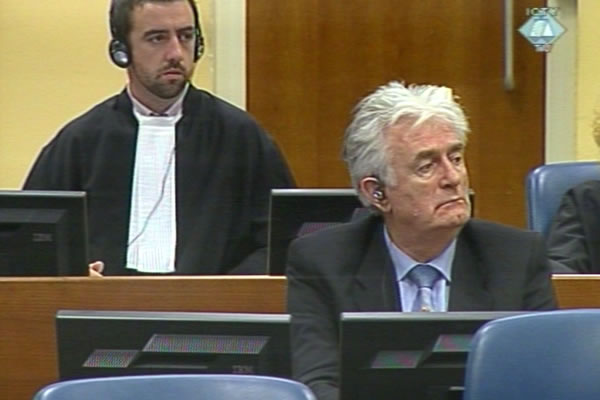Home
EXODUS OF NON-SERBS FROM BOSANSKI NOVI
At the trial of Radovan Karadzic, protected witness KDZ 011 spoke about the expulsion of the non-Serbs from the Bosanski Novi area in May and June 1992. Former UN official Charles Kirudja began his evidence
 Radovan Karadzic in the courtroom
Radovan Karadzic in the courtroom The trial of Radovan Karadzic continued with the evidence of protected witness KDZ 011, who spoke about the expulsion of non-Serbs from Bosanski Novi in May and June 1992. The transcript of the witness’s testimony at the trial of the former president of the Crisis Staff and War Presidency of the Autonomous Region Krajina Radoslav Brdjanin was admitted into evidence. Brdjanin was sentenced to 30 years for crimes in northwestern Bosnia and Herzegovina.
Prosecutor Ann Sutherland read out the summary of the witness’s evidence. At the Brdjanin trial, the witness spoke about the drive to disarm the non-Serbs in the village of Suhace near Bosanski Novi, the shelling of the village by the Serb forces, and about the expulsion of about 1,200 villagers from the village. They were forced to leave their homes in a mass exodus of about 8,000 inhabitants of other villages in the Bosanski Novi region on 24 May 1992.
As the witness recounted, at one point the Serbs stopped the convoy and returned the refugees to the village of Blagaj Japra. Some days later, the women and children were transported to Doboj. The men were first driven in cattle wagons towards Prijedor but were then returned to Bosanski Novi. There they were detained in the town stadium, called Mlakve. The prisoners received starvation rations: in the 46 days of detention, the witness lost 11 kilos. Before they were released, the prisoners were forced to sign documents waiving their right to their property.
In the cross-examination, Karadzic tried to prove that the Muslims in Suhace and other villages in the Bosanski Novi region started putting together a military organization by mid-June 1991; their intention was to fight the Serbs. Karadzic argued that this was the reason why Muslims were arrested and detained in May 1992. The witness replied that the purported ‘rebellion masterminds’ in the village of Suhace were in fact those who organized the surrender of the weapons. Karadzic then put it to the witness that, given the fighting around Bosanski Novi, it was ‘safer’ in the stadium than anywhere else. The witness replied that for him it would have been better if he had stayed at home.
In a bid to contest the witness’s credibility, Karadzic’s legal advisor Peter Robinson put it to the witness that his testimony in The Hague made it possible for him to be granted permanent residence in the country where he has lived since his departure from BH in 1992. Robinson noted that in 1999 the witness faced deportation from that country, but then the OTP intervened and the witness residence permit was extended.
After the protected witness KDZ 011 completed his evidence, the prosecution called Charles Kirudja, former special advisor to the UN envoy to the former Yugoslavia Yasushi Akashi. A written statement based on Kirudja’s six previous testimonies at the trials in The Hague was admitted into evidence. At those trials, Kirudja testified about the expulsion of non-Serbs from Northern Bosnia and Herzegovina and about the ‘hostage crisis’ in the spring of 1995.
Linked Reports
- Case : Karadzic
- 2011-11-09 RADOVAN KARADZIC MEETS ED VULLIAMY FOR THE SECOND TIME
- 2011-11-08 WITNESS: WE HAD TO WAIT FOR ‘MORE PROPITIOUS MOMENT’ TO PUNISH CRIMES
- 2011-11-03 INVESTIGATING MASSACRE AT KORICANSKE STIJENE
- 2011-11-11 ‘VOLUNTARY’ EXODUS
- 2011-11-14 KARADZIC SEEKS YET ANOTHER SUSPENSION OF TRIAL
- 2011-11-16 PREPARATIONS FOR JOURNALISTS’ VISIT TO PRISON CAMPS
